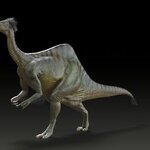The femur that led to the oldest modern human genome. Credit: Bence Viola, MPI EVA
By Daniel Zadik, University of Leicester
When a human bone was found on a gravelly riverbank by a bone-carver who was searching for mammoth ivory, little did he know it would provide the oldest modern-human genome yet sequenced.
The anatomically modern male thigh-bone, found near the town of Ust’-Ishim in south-western Siberia, has been radiocarbon-dated to around 45,000 years old.
This was an interesting time in human prehistory. Although within the most-recent ice age, it was a relatively warm period,…
Paleontology

Deinocheirus mirificus. Credit: Yuong-Nam Lee
By Stephen Brusatte, University of Edinburgh
Everywhere scientists look it seems like they are finding dinosaurs. A new species is emerging at the astounding pace of one per week. And this continues with the announcement of perhaps the strangest dinosaur find over the past few years: the toothless, hump-backed, super-clawed omnivore Deinocheirus mirificus that lived about 70m years ago in what is now Mongolia.
Deinocheirus may even become a household name, thanks to spectacular new fossils from the Gobi Desert reported by South Korean…

By pairing chemical analyses with micropaleontology, the study of tiny fossilized organisms, researchers believe they can decipher how global marine life was affected by a rapid warming event more than 55 million years ago.
The work revolves around the Paleocene-Eocene Thermal Maximum (PETM), a well-studied analogue for modern climate warming. Documenting the expansion of OMZs during the PETM is difficult because of the lack of a sensitive, widely applicable indicator of dissolved oxygen.
"Global warming impacts marine life in complex ways, of which the loss of dissolved…

Sauropods, large, long-necked plant-eating dinosaurs such as Diplodocus and Brachiosaurus, are the largest animals to have ever walked the Earth, with the biggest weighing 80 tons.
Clearly, a single creature the size of 11 elephants would have needed vast amounts of food. How did multiple sauropod species live alongside one another in prehistoric ecosystems between 210 and 65 million years ago?
New research from the University of Bristol and the Natural History Museum, London details the community of the Late Jurassic Morrison Formation, a distinctive sequence of…

A 52-million-year old beetle was able to live alongside ants—preying on their eggs and usurping resources—within the comfort of their nest. Somehow.
The fossil, encased in a piece of amber from India, is the oldest-known example of this kind of social parasitism, known as "myrmecophily." The research also shows that the diversification of these stealth beetles, which infiltrate ant nests around the world today, correlates with the ecological rise of modern ants.
Today, there are about 370 described species belonging to Clavigeritae, a group of myrmecophilous, or "ant-loving" beetles…

Phytosaur: still got it. Credit: BFS Man, CC BY
By Stephanie Drumheller, University of Tennessee; Michelle Stocker, Virginia Tech, and Sterling Nesbitt, Virginia Tech
Some 220 million years ago, the Triassic Period marked the beginning of the age of dinosaurs. But by the time the earliest dinosaurs were just starting to appear in the fossil record, it was distant relatives of crocodiles that reigned over both the water and land.
Among these ancient reptiles, crocodile-like phytosaurs were the largest aquatic predators, whereas gigantic rauisuchids ruled the land. We know both of these animals…

The first truly semi-aquatic dinosaur, Spinosaurus aegyptiacus, has been announced.
New fossils of the massive Cretaceous-era predator reveal it adapted to life in the water some 95 million years ago, providing the most compelling evidence to date of a dinosaur able to live and hunt in an aquatic environment.
The fossils also indicate that Spinosaurus was the largest known predatory dinosaur to roam the Earth, measuring more than 9 feet longer than the world's largest Tyrannosaurus rex specimen.
An international research team found that Spinosaurus developed a variety of…

Evolution is still the favored theory, according to fossil records. Credit: Flickr/Brent Danley, CC BY-NC-SA
By John Long, Flinders University
Charles Darwin’s Theory of Evolution, first published in 1859, offered a bold new explanation for how animals and plants diversified and still serves as the foundation underpinning all medical and biological research today. But the theory remains under attack by creationists in various parts of the world, particularly the US, Turkey, Indonesia and the Middle East.
Perhaps three of the most powerful ways to test evolution are through comparative…

A new species of titanosaurian, a member of the large-bodied sauropods that thrived during the final period of the dinosaur age, has been found in Tanzania.
Many fossils of titanosaurians have been discovered around the globe, notably in South America, but few have been recovered from the continent of Africa.
The new species, named Rukwatitan bisepultus, was first spotted by scientists embedded in a cliff wall in the Rukwa Rift Basin of southwestern Tanzania. Using the help of professional excavators and coal miners, the team unearthed vertebrae, ribs, limbs and pelvic bones over the…

A new supermassive dinosaur species with the most complete skeleton ever found of its type has been unveiled. Dreadnoughtus schrani was 85 feet long and weighed about 65 tons in life, making iy the largest land animal for which a body mass can be accurately calculated.
Its skeleton is exceptionally complete, with over 70 percent of the bones, excluding the head, represented. Because all previously discovered supermassive dinosaurs are known only from relatively fragmentary remains, Dreadnoughtus offers an unprecedented window into the anatomy and biomechanics of the largest animals to…
